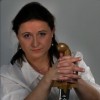The BBC recently featured and article on the language of love which listed a number of (some unusual) terms of endearment used in different languages, and a Dictionary of Affectionyms (Terms of Endearment) has just been published in Polish. This inspired me to remember some of the terms I came across when living in and visiting different countries, and I decided to check out the situation in the Polish language of love again – on the premise that language evolves all the time, and there might be new developments in that area.
Terms of endearment (aka pet-names etc.) are words which may not in the new context bear any resemblance to the original meaning, for example when calling your significant other: “baby-doll”, “munchkins” or "pumpkin". Some words are clearly derived from each other, such as "sweetheart", "sweetie", and "sweetie-pie", while others bear no etymological resemblance, such as "baby" and "cutie". "Honey" has been documented as a term of endearment as far back as the 14th century. "Baby" was supposedly first used in 1839 and "sugar" only appears as recently as 1930.
In most cases terms of endearment are simply nicknames or pet-names for people in some close or intimate relationship (lovers, partners, friends, family members). Many such terms are only used when two people are alone with each other and sometimes they are used only in specific situations, very occasionally or even on a single special occasion. It is quite a volatile linguistic phenomenon and hence difficult to study. The Polish researchers behind the Dictionary of Affectionyms (“Czułe słowka” - Agnieszka Zygmunt i Mirosław Bańko) and other researchers in this field (Jacek Perlin, Maria Milewska) have come across some interesting findings.
In general:
- Terms of endearment reveal little or nothing about the true quality of the relationship in question;
- It is not true that nations considered (stereotypically) to be ‘more romantic” (eg. Spaniards, Italians ) are also linguistically more developed in this department;
- In fact, it seems that Poles and the Dutch are considered the most developed nations in terms of the sheer amount and their creativity for terms of endearment;
- Spanish endearments are usually very poetic and somewhat exalted;
- The Dutch and Polish languages are known for the greatest proliferation of animal associated terms of endearment;
- Dutch terms are sometimes based on abstract humour, while the Spanish ones are rarely humorous at all;
- Dutch terms of endearment are not usually childish, while the Italian ones frequently are;
- In both Polish and French quite a few terms of endearment refer to somewhat ‘disgusting’ animals or use words that would be considered derogative in the original meaning.
It is therefore obvious that, like idioms, terms of endearment stem from our individual and/or national creativity and linguistic imagination, so it is very difficult to create a comprehensive dictionary of these terms because, apart from some traditionally popular terms, the genre evolves quickly and in an unpredictable way. Also, people are quite willing to share the traditional and typical terms but less inclined to volunteer the details of actual ‘bedroom talk” (aka dirty talk). Obviously, what sounds great in certain intimate contexts, would in most public situations be considered gross or downright ridiculous.
There is quite a lot of political correctness when it comes to the typical situations and popular terms of endearment. They say Carla Bruni calls Sarky “Chouchou”, Michelle refers to Barack Obama as ‘honey”, and the Christian Grey character may be into BDSM but he still usually refers to Ana as “baby”. Some terms of endearment are popular in many languages – “baby”, “angel”, “sweetheart”, and ‘love”, for example. But there are many interestingly local and culture-specific terms.
Here are some examples of the language of love around the world – taken from the above mentioned articles, dictionary, and personal research.
1. Little cabbage (French)
Petit chou
“Chou” (cabbage) is the French equivalent of “sweetheart”.
2. Pumpkin (Brazil / Portuguese)
Chuchuzinho
“Chuchu” is the word for “squash” – but strangely similar to the French “chouchou”.
3. Egg with eyes (Japanese)
Tamago gata no kao
In Japan, women are frequently called “an egg with eyes” by those who love them.
4. Lump of sugar (Spanish)
Terron de azucar
Like “honey” in English, sweet foodstuffs of one kind or another make popular terms of endearment in numerous languages.
5. Fruit of my heart (Indonesian)
Buah hatiku
Although the term can be used romantically, featuring in love songs and poems, today it is most often used to express affection for children.
6. My flea (French)
Ma puce
“Ma puce” is roughly equivalent to “sweetie” in English.
7. Gazelle (Arabic)
Ghazal
Classical Arabic poetry abounds with the imagery of beautiful gazelles (i.e women with beautiful eyes - metaphorically speaking).
Habibi/habibati (my love) is probably still the most popular term of endearment in Arabic.
8. Little elephant (Thai)
Chang noi
Elephants are the dearest of animals to Thai people.
9. Diving fish swooping geese (Chinese)
Chen yu luo yan
Based on classical Chinese legends of two of the most beautiful Chinese women ever. At the sight of one the fish would dive to the bottom of a lake, at the sight of the other the geese would swoop from the skies.
10. Little dove (Russian)
Golubchik (masc) / golubushka (fem)
Pushkin used the word “little dove” to refer affectionately to his elderly nanny in the lines of one of his best-known poems, but she could equally have used it to refer to him, when he was a child (and probably did). This term is popular not only in Russian but also other Slavic languages.
Polish
The Polish language which is traditionally quite deficient in explicit sexual vocabulary makes up for this by being incredibly prolific when it comes to terms of endearment. The above mentioned dictionary was preceded by some research and it seems that it is not only a question of sheer numbers but the Polish language can also boast a wide range of these terms. The typical categories would naturally be:
Animal-related:
misiu (teddy bear), kotku (little cat), kurczaczku (chick), myszko (little mouse), żabciu (froggie), gołąbeczku (little dove), sroczko (little magpie), tygrysku (litte tiger), pszczółko (little bee), rybko (little fishy), żuczku (little beatle) etc.
Traditional romantic:
kochanie (love), księżniczko (princess), królowo (queen), maleńka (little one), laleczko (little doll), serce (heart), jedyna moja (my only one), słoneczko (little sun), skarbie (treasure), laska (babe) etc.
However, some Polish terms of endearment seem to be quite unique and difficult to classify (especially the ones referring to men):
kruszynko (breadcrumb), dzikusku (little savage), dziadzie/dziadu (old fart), brzydalu (ugly one), capie (goat), pączusiu (little donut), robaczku (little worm), kluseczko (little noodle), mysiu-pysiu (mouse-snout), mój złoty (my golden one), chujku (little dick) etc.
One thing is certain, in both Dutch and Polish (the most popular languages for terms of endearment) the key thing is to use the diminutive form of a word.In Polish this would mean that the word will usually end in “-ek”,”-czka“, “-czku”, ”-siu“. This seems to be the key to success when creating original terms of endearment.
Upon reflection, I suspect that there is a world of fantastic and original terms of endearment out there in all languages that have not been mentioned in any study or in any articles I have come across on this subject.
Please share if you have any favourite, particularly outrageous or charming ones.
See also:
http://natemat.pl/15415,tesknoto-malenka-myszku-czule-slowka-po-polsku
http://www.bbc.co.uk/news/magazine-22699938
http://www.edulandia.pl/edukacja/1,101856,7549847,Polakow_czule_slowka.html#ixzz2UnZGPmtJ









